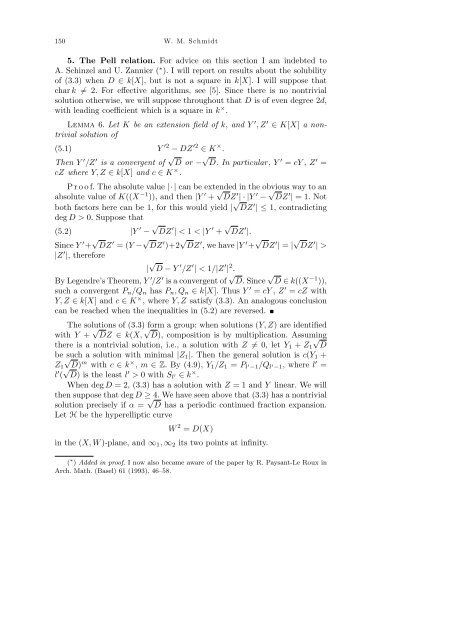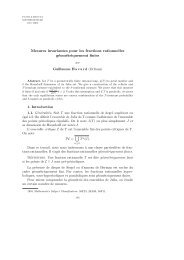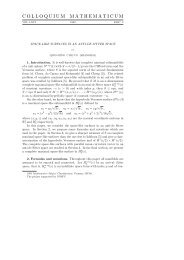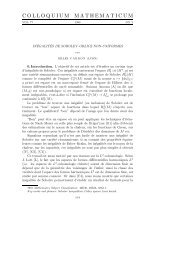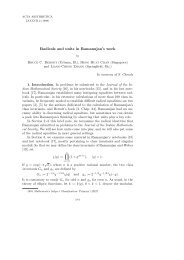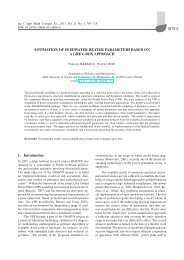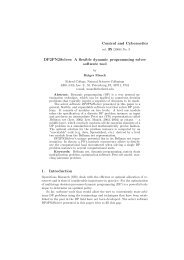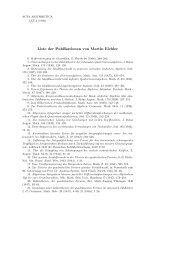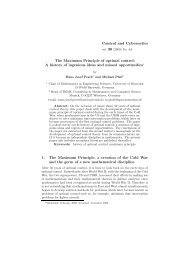On continued fractions and diophantine approximation in power ...
On continued fractions and diophantine approximation in power ...
On continued fractions and diophantine approximation in power ...
You also want an ePaper? Increase the reach of your titles
YUMPU automatically turns print PDFs into web optimized ePapers that Google loves.
150 W. M. Schmidt<br />
5. The Pell relation. For advice on this section I am <strong>in</strong>debted to<br />
A. Sch<strong>in</strong>zel <strong>and</strong> U. Zannier ( ∗ ). I will report on results about the solubility<br />
of (3.3) when D ∈ k[X], but is not a square <strong>in</strong> k[X]. I will suppose that<br />
char k = 2. For effective algorithms, see [5]. S<strong>in</strong>ce there is no nontrivial<br />
solution otherwise, we will suppose throughout that D is of even degree 2d,<br />
with lead<strong>in</strong>g coefficient which is a square <strong>in</strong> k × .<br />
Lemma 6. Let K be an extension field of k, <strong>and</strong> Y ′ , Z ′ ∈ K[X] a nontrivial<br />
solution of<br />
(5.1) Y ′2 − DZ ′2 ∈ K × .<br />
Then Y ′ /Z ′ is a convergent of √ D or − √ D. In particular, Y ′ = cY , Z ′ =<br />
cZ where Y, Z ∈ k[X] <strong>and</strong> c ∈ K × .<br />
P r o o f. The absolute value | · | can be extended <strong>in</strong> the obvious way to an<br />
absolute value of K((X −1 )), <strong>and</strong> then |Y ′ + √ DZ ′ | · |Y ′ − √ DZ ′ | = 1. Not<br />
both factors here can be 1, for this would yield | √ DZ ′ | ≤ 1, contradict<strong>in</strong>g<br />
deg D > 0. Suppose that<br />
(5.2) |Y ′ − √ DZ ′ | < 1 < |Y ′ + √ DZ ′ |.<br />
S<strong>in</strong>ce Y ′ + √ DZ ′ = (Y − √ DZ ′ )+2 √ DZ ′ , we have |Y ′ + √ DZ ′ | = | √ DZ ′ | ><br />
|Z ′ |, therefore<br />
| √ D − Y ′ /Z ′ | < 1/|Z ′ | 2 .<br />
By Legendre’s Theorem, Y ′ /Z ′ is a convergent of √ D. S<strong>in</strong>ce √ D ∈ k((X −1 )),<br />
such a convergent Pn/Qn has Pn, Qn ∈ k[X]. Thus Y ′ = cY , Z ′ = cZ with<br />
Y, Z ∈ k[X] <strong>and</strong> c ∈ K × , where Y, Z satisfy (3.3). An analogous conclusion<br />
can be reached when the <strong>in</strong>equalities <strong>in</strong> (5.2) are reversed.<br />
The solutions of (3.3) form a group: when solutions (Y, Z) are identified<br />
with Y + √ DZ ∈ k(X, √ D), composition is by multiplication. Assum<strong>in</strong>g √<br />
there is a nontrivial solution, i.e., a solution with Z = 0, let Y1 + Z1 D<br />
be such a solution with m<strong>in</strong>imal |Z1|. Then the general solution is c(Y1 +<br />
Z1<br />
√ D) m with c ∈ k × , m ∈ Z. By (4.9), Y1/Z1 = Pl ′ −1/Ql ′ −1, where l ′ =<br />
l ′ ( √ D) is the least l ′ > 0 with Sl ′ ∈ k× .<br />
When deg D = 2, (3.3) has a solution with Z = 1 <strong>and</strong> Y l<strong>in</strong>ear. We will<br />
then suppose that deg D ≥ 4. We have seen above that (3.3) has a nontrivial<br />
solution precisely if α = √ D has a periodic <strong>cont<strong>in</strong>ued</strong> fraction expansion.<br />
Let H be the hyperelliptic curve<br />
W 2 = D(X)<br />
<strong>in</strong> the (X, W )-plane, <strong>and</strong> ∞1, ∞2 its two po<strong>in</strong>ts at <strong>in</strong>f<strong>in</strong>ity.<br />
( ∗ ) Added <strong>in</strong> proof. I now also became aware of the paper by R. Paysant-Le Roux <strong>in</strong><br />
Arch. Math. (Basel) 61 (1993), 46–58.


